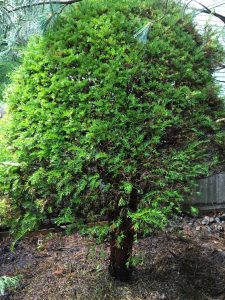
I am in Boston. My neighbor had three large yews, (2 are 9′ H, 5′ W, 1 is 7’H 4’W), he announced he wanted to get rid of them. They had been manicured round for years. I tried to transplant them to my property across the street, to a spot with somewhat less sun, right next to some leland cypress trees. I watered them religiously for a month. (It has been very hot and dry). All seemed well, but then I found a good deal of browning and death on on side and around the bottom of one large one. On closer inspection I discovered a good deal of material gathered in the crotches of the tree. I cleaned it out carefully, and at the bottom, found a tennis ball lodged deep in the main crotch, it must have been there for years, and the stress of the move added to the problem, throwing many limbs over the edge of coping. I carefully got it out, and gently cleaned all. now the bottom of the trunk is exposed to air and light and looks pretty healthy, but several large branches of the main trunk look sick, and while I have removed as much dead needles as I dare, I want to proceed in stages. Can my yew survive? There are several spots elsewhere on the tree that have new growth! It is slight, but it is there….
Thank you for contacting the Toronto Master Gardeners.
One of the main reasons trees struggle after being planted or transplanted is because they lose a massive amount of their root system during the process making them more susceptible to pests, diseases, water stress and environmental problems. This makes it hard for the tree to bounce back once it is replanted in a new location. Giving the tree adequate water, fertilizer and mulch reduces the risk of stress and transplant shock.
Provide transplanted evergreens with at least 1 inch of water per week during the first year. Water less frequently if you planted the tree in clay soil or more frequently if in sandy soil. Add a two-to-four-inch deep layer of mulch from the tree’s base to its outermost leaves making sure that the mulch is a few inches away from the trunk.
If hydration doesn’t seem to be working, think back to when you first planted the tree. Was the hole the right size? It’s incredibly important for the planting hole to be 2 to 3 times larger than the tree’s root spread and deep enough for the root flare (where the tree starts to widen) to sit slightly above ground.
The last step in a successful transplant process is patience! Some trees take two or more years to get rid of all their stress symptoms. Occasionally, it can even take up to 5 years for trees to fully recover.
According to Rutgers Masster Gardeners of Mercer County:
“A tree is considered a transplant for at least 2 years and for as long as 10 years, depending on species and speed ofrecovery, no matter how old it is when planted. (One rule-of-thumb is that transplant recovery takes the diameter-of-the-tree-plus-one in years. For example, a three-inch caliper tree should take 4 years to recover from transplanting.) Even a tree that is drought tolerant or wet site tolerant when established will not have that tolerance for the first two to four years that it takes to redevelop a strong root system.”
Lastly, you may wish to contact the Master Gardener group in your area. You can find them at this link.

